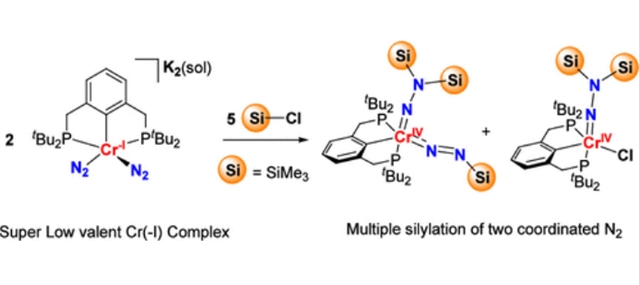
二氮(N2)固定化学长期追求的目标是直接由N2合成含氮化学物质。迄今为止,过渡金属二氮配合物的配体亲电攻击是构建氮元素键最直接的途径。虽然单二氮配合物的亲电官能化已经得到了充分的证明,但对于那些含有多个N2基团的配合物,类似的反应总是导致N2的萃取,最多只能衍生出一个N2。
研究组描述了一个单核形式铬(I)由PCP钳形配体支撑的双二氮配合物。具体而言,用TMSCl(TMS=SiMe3)处理会导致其两个N2配体的甲硅烷基化,并在从Cr(II)双二叠氮基中间体开始的过程中,与1:1比例的Cr(IV)一酰肼物种一起,干净地形成带有二叠氮和肼基单元的Cr(Ⅳ)络合物。这是首次在一个金属中心上实现两个N2配体的功能化。
相比之下,以TMSOTf代替TMSCl作为亲电试剂的反应产生了Cr(III)腙配合物。在详细分析三硅基化反应电子结构演化的基础上,采用基于高度相关波函数的从头算方法,确定了两种N2配体官能化的必要条件,即双二氮配合物必须具有非竞争性的8电子M-(N2)2 π反给体。研究组讨论了为了满足这一要求,如何设计合适的二氮配合物来实现这一具有挑战性的转变。
附:英文原文
Title: Trisilylation of a Formal Cr(I) Bis-dinitrogen Complex
Author: Botao Wu, Wang Chen, Haihan Yan, Xinchao Zhang, Junnian Wei, Zhenfeng Xi, Gao-Xiang Wang, Shengfa Ye
Issue&Volume: August 25, 2025
Abstract: The long-sought goal of dinitrogen (N2) fixation chemistry is to effect facile synthesis of nitrogen-containing chemicals directly from N2. To date, electrophilic attack of coordinated N2 ligands of transition metal dinitrogen complexes represents the most straightforward route to construct nitrogen-element bonds. Although electrophilic functionalization of monodinitrogen complexes to furnish diazenido and hydrazido species has been well-documented, for those complexes containing multiple N2 moieties, analogous reactions invariably lead to N2 extrusion and at most one N2 can be derivatized. Herein, we describe electrophilic functionalization of a mononuclear formal chromium(I) bis-dinitrogen complex supported by a PCP-pincer ligand. Specifically, treatment with TMSCl (TMS = SiMe3) results in silylation of its two N2 ligands and clean formation of a Cr(IV) complex bearing a diazenido and a hydrazido unit en route from a Cr(II) bis-diazenido intermediate, alongside a Cr(IV) monohydrazido species in a 1:1 ratio. This is the first time that functionalization of two N2 ligands on a single metal center has been realized. In contrast, the reaction using TMSOTf instead of TMSCl as the electrophile generates a Cr(III) hydrazido complex. On the basis of detailed analyses of the electronic structure evolution during the trisilylation reaction using highly correlated wave function-based ab initio approaches, we identify a necessary condition for functionalization of two N2 ligands, viz., bis-dinitrogen complexes ought to feature noncompetitive eight-electron M-(N2)2 π-backdonation. To satisfy this requirement, how to design appropriate dinitrogen complexes to effect this challenging transformation is discussed.
DOI: 10.1021/jacs.5c05591
Source: https://pubs.acs.org/doi/abs/10.1021/jacs.5c05591
JACS:《美国化学会志》,创刊于1879年。隶属于美国化学会,最新IF:16.383
官方网址:https://pubs.acs.org/journal/jacsat
投稿链接:https://acsparagonplus.acs.org/psweb/loginForm?code=1000
